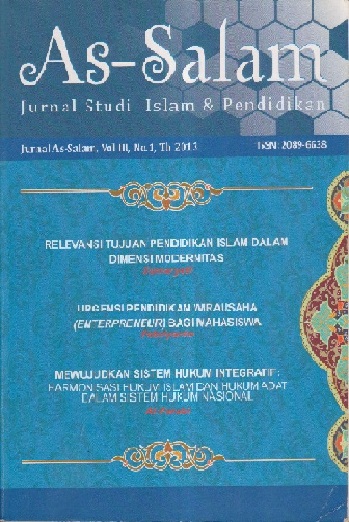MULTIMEDIA PEMBELAJARAN BERBASIS KOMPUTER SEBAGAI UPAYA MENINGKATKAN HASIL BELAJAR SISWA
Abstract
Development of science and technology in all fields exert influence either directly or indirectly, to the quality of the teaching learning to be achieved, therefore, efforts should be done to improve the quality of learning in the case which has remained low. Generally poor quality of learning can be seen from both sides which is from the side and from the side of the result. Multimedia learning is a component that can be used in supporting the learning process. It is firmly based on the perception that learning will take place with good, effective, and fun if supported by a learning medium to attract interest and attention of students. Using computer-based multimedia can make students better remember the material being learned. Therefore highly effective multimedia and become a powerful tool in teaching and education. The use of multimedia software in teaching and learning process will increase efficiency, enhance motivation, facilitating active learning, facilitate the experimental study, consistent with the study based on the student, and the drive to learn better.
Downloads
References
Agnew, Palmer W., Kellerman, Anne S., Meyer, Jeanine M. Multimedia in
The Classroom. Boston: Allyn & Bacon, 1996.
Anderson, Lorin W. & Krathwohl, David R. A Taxonomy for Learning,
Teaching, and Assessing. A Revision of Bloom’s Taxonomy of Educational
Objectives. New York: Longman Inc., 2001.
Arsyad, Azhar. Media Pendidikan. Jakarta: Raja Grafindo Persada, 2007.
Bloom, Benyamin S., Engelhart, Max D., Furst, Edward J., et al. Taxonomy of
educational objectives. London: Longman Group LTD., 1979.
B. Uno. Hamzah, Teori Motivasi Dan Pengukurannya. Jakarta: Bumi Aksara.
Chee, Tan Seng & Angela F. L. Wong. Teaching and Learning With
Technology. An Asia Pacific Perspective. Singapore: Prentice Hall. 2003.
Djamarah, Syaiful B. Psikologi Belajar. Jakarta: PT. Rineka Cipta. 2008.
Gagne, Robert M. & Brigs, Leslie J. Principles of instructional design. Second
edition. United States of America: Holt Rinehart and Winston, 1979.
Hackbarth, Steven. The educational technology handbook: A Comprehensive
guide process and product for learning. New Jersey: Educational
Technology Publications, Inc. 1996.
Hadi Sutopo, Ariesto, Multimedia Interaktif Dengan Flash. Yogyakarta:
Graha Ilmu, 2003.
Hamalik, Oemar. Psikologi Belajar dan Mengajar. Bandung: Sinar Baru
Algensindo. 2001.
Mayer, Richard E. Multimedia Learning. terj. Teguh Wahyu Utomo,
Yogyakarta: Pustaka Pelajar, 2009.
Philips, Rob. Multimedia. A Practical Guide For Educational Applications.
London: Kogan Page Limited. 1997.
Pramono, Gatot. Pemanfaatan Multimedia Pembelajaran. (Modul 7:
Pelatihan Pengembangan dan Pemanfaatan Konten Jardiknas Tingkat
Nasional). Jakarta: Kementerian Pendidikan Nasional: Pusat Teknologi
Informasi dan Komunikasi Pendidikan. 2010.
Rubinson, Donna, Developing Instructional Multimedia – A Realistic
Look,dalam http://www.uic.edu/depts/accc/newsletter/adn06/
realistic.html, akses pada 18 Oktober 2013.
Sudhata, I Gde Wawan, Pemanfaatan Multimedia Dalam Pembelajaran
Di Kelasdalamhttp://www.undiksha.ac.id/tp/files/, akses pada 14
Oktober 2013.
Sudjana, Nana. Dasar-dasar Proses Belajar Mengajar. Bandung: Sinar
Baru Algesindo. 2009.
Suyanto, M. Multimedia Alat Untuk Meningkatkan Keunggulan Bersaing.
Yogyakarta: ANDI. 2003
Winarno, Abdullah Patwary, Abu Yasid, et al. Teknik Evaluasi Multimedia
Pembelajaran.Genius Prima Media. 2009.
















